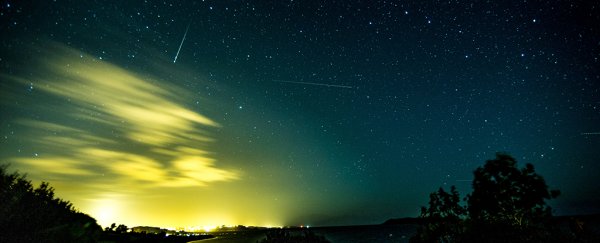The Geminids meteor shower is likely to flaunt the brightest shooting stars of 2020. It peaks Sunday night.
The shower is expected to produce about 120 yellow, green, orange, red, and blue shooting stars per hour. The brightest of these meteors leave glowing trails in their wake.
The Moon won't outshine any of the meteors, since it will hang dark and nearly invisible in the night sky.
"It's worth braving the cold during this shower's peak," Diana Hannikainen, observing editor at Sky & Telescope, said in a statement.
"The Geminids offer the best display of 'shooting stars' all year."
She added that clear skies might reveal a new meteor every minute or two from 10 pm local time until dawn.
The asteroid 3200 Phaethon left behind the trail of dust that's responsible for the Geminids several thousand years ago.
That makes the Geminids unique, since most meteor showers come from the dust of a comet (a ball of ice and rock) rather than a asteroid (a bare space rock).
As Earth orbits the Sun, it crosses Phaethon's orbital path each December, ploughing through the trail of debris that the asteroid has shed. Though these bits of space rock can be as small as grains of sand, they burn up in the atmosphere and emit brilliant flares of light.
The shooting stars' distinct colours come from different chemical elements in the rock. Burning magnesium, for example, shines blue-green, while iron burns yellow, as astronomer Samantha Rolfe explained in The Conversation.
In 2019, NASA's Parker Solar Probe spotted the Geminids debris trail for the first time ever. Thanks to the probe's observations, scientists found that the Geminids trail contains about 1 billion kilograms (1 million tons) of material.
On Sunday night, you can watch some of that space rock streaking across the sky as it burns in the atmosphere.
How to watch the Geminids
For the best viewing opportunities, bundle up and get as far from city lights as you can. Find a comfortable spot to lay on your back with an open view of the stars. (Hint: A reclining chair can be a meteor-watcher's best friend.) Wait 30 minutes for your eyes to adjust to the dark.
The show will begin after night falls, as early as 8 pm. It reaches its peak at 2 am local time.
The shooting stars can appear anywhere in the sky, but if you need a reference point, look to the constellation Gemini, from which the Geminids often appear to emerge. (That's how they get their name.)
After the Geminids, the next meteor shower to look for will be the Ursids, which peak on the night of December 21.
This article was originally published by Business Insider.
More from Business Insider:
